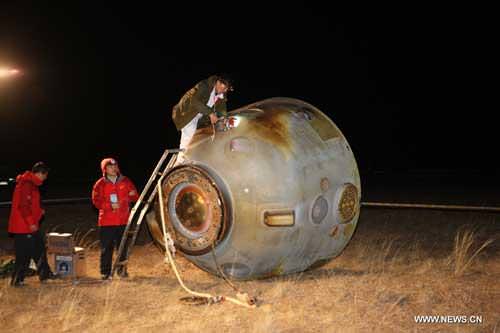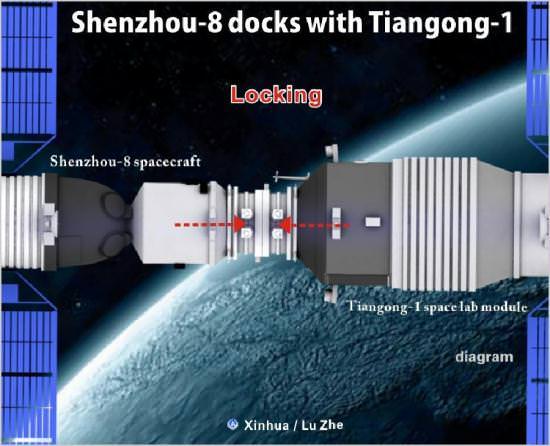Communication between spacecraft relies upon line of site technology, if anything is in the way, communication isn’t possible. Exploration of the far side of the Moon is a great example where future explorers would be unable to communicate directly with Earth. The only way around this is to use relay satellites and the Chinese Space Agency is on the case. The first Queqiao-1 was able to co-ordinate communications with Chang’e-4 landers and now they are sending Queqiao-2 to support the Change’e-6 mission.
Continue reading “China’s Next Lunar Relay Satellite Blasts Off”China’s Yutu Moon Rover Unable to Properly Maneuver Solar Panels

This time-lapse color panorama from China’s Chang’e-3 lander shows the Yutu rover at two different positions during its trek over the Moon’s surface at its landing site from Dec. 15-18, 2013. This view was taken from the 360-degree panorama.
Credit: CNSA/Chinanews/Ken Kremer/Marco Di Lorenzo.
See our complete 5 position Yutu timelapse pano herein and 3 position pano at NASA APOD Feb. 3, 2014: http://apod.nasa.gov/apod/ap140203.htm
Story updated[/caption]
The serious technical malfunction afflicting the life and continued operations of China’s Yutu moon rover since the start of its second Lunar Night time hibernation in late January 2014 has been identified as an inability to properly maneuver the life giving solar panels, according to a top Chinese space official.
“Yutu suffered a control circuit malfunction in its driving unit,” according to a newly published report on March 1 by the state owned Xinhua news agency.
“The control circuit problem prevented Yutu from entering the second dormancy as planned,” said Ye Peijian, chief scientist of the Chang’e-3 program, in an exclusive interview with Xinhua.
At the time that Yutu’s 2nd Lunar sleep period began on Jan. 25, 2014, Chinese space officials had announced that the robot’s future was in jeopardy after it suffered an unidentified “ mechanical control anomaly” due to the “complicated lunar surface.”
A functioning control circuit is required to lower the rovers mast and protect the delicate components and instruments mounted on the mast from directly suffering from the extremely harsh cold of the Moon’s recurring night time periods.
“Normal dormancy needs Yutu to fold its mast and solar panels,” said Ye.
The high gain communications antenna and the imaging cameras are attached to the mast.
They must be folded down into a warmed electronics box to shield them from the damaging effects of the Moon’s nightfall when temperatures plunge dramatically to below minus 180 Celsius, or minus 292 degrees Fahrenheit.
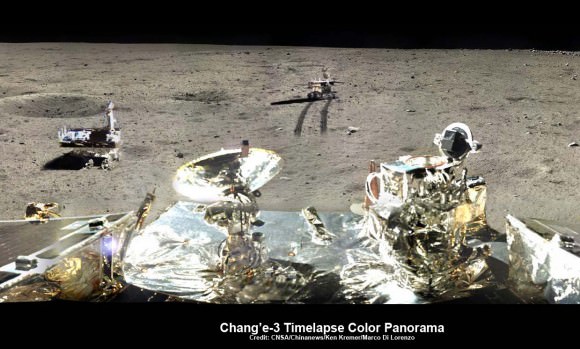
This newly expanded timelapse composite view shows China’s Yutu moon rover at two positions passing by crater and heading south and away from the Chang’e-3 lunar landing site forever about a week after the Dec. 14, 2013 touchdown at Mare Imbrium. This cropped view was taken from the 360-degree timelapse panorama. See complete 360 degree landing site timelapse panorama herein and APOD Feb. 3, 2014. Chang’e-3 landers extreme ultraviolet (EUV) camera is at right, antenna at left. Credit: CNSA/Chinanews/Ken Kremer/Marco Di Lorenzo – kenkremer.com. See our complete Yutu timelapse pano at NASA APOD Feb. 3, 2014: http://apod.nasa.gov/apod/ap140203.htm
The solar panels also generate power during each Lunar day to keep the robot alive and conduct its mission of scientific exploration roving across the lunar terrain.
The rover and Chang’e-3 stationary lander must power down and sleep during each lunar night since there is no sunlight available to generate power and no communications are possible with Earth.
The panel driving unit also helps maneuver the panels into position to efficiently point to the sun to maximize the electrical output.
“The driving unit malfunction prevented Yutu to do those actions” said Ye.
Each lunar day and night lasts for alternating periods of 14 Earth days.
“This means Yutu had to go through the lunar night in extremely low temperatures.”
Apparently the mast was not retracted and remained vertical during the lunar nights 2 and 3.
And the camera somehow survived the harsh temperature decline and managed to continue operating since it snapped two images of the Chan’ge-3 lander during Lunar Day 3. See our two image mosaic – below.

In addition to being chief scientist of the Chang’e-3 program Ye is also a member of the National Committee of the Chinese People’s Political Consultative Conference, the country’s top political advisory body.
Yutu is China’s first ever Moon rover and successfully accomplished a soft landing on the Moon on Dec. 14, 2013, piggybacked atop the Chang’e-3 mothership lander.
Barely seven hours after touchdown, the six wheeled moon buggy drove down a pair of ramps onto the desolate gray plains of the lunar surface at Mare Imbrium (Sea of Rains) covered by volcanic material.
For a time in mid-February, mission scientists feared that Yutu would no longer function when because no signals were received until two days later than the planned “awakening” from Lunar Night 2 on Feb. 10.
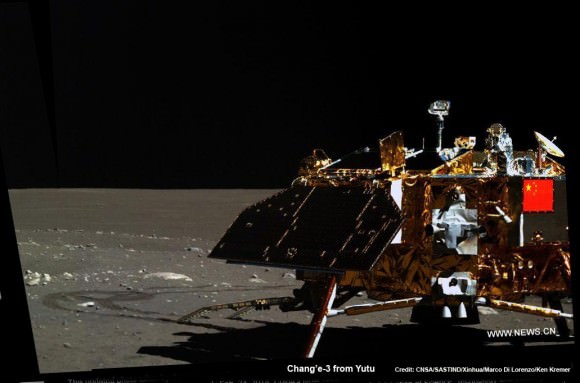
Fortunately, Yutu did finally wake up some 48 hours late on Feb. 12 and function on Lunar Day 3.
And the team engaged in troubleshooting to try and identify and rectify the technical problems.
Since then, Chinese space engineers engaged in troubleshooting to try and identify and rectify the technical problems in a race against time to find a solution before the start of Lunar Night 3.
The 140 kilogram rover was unable to move during Lunar Day 3 due to the mechanical glitches.
“Yutu only carried out fixed point observations during its third lunar day.” according to China’s State Administration of Science, Technology and Industry for National Defence (SASTIND), responsible for the mission.
However it did complete some limited scientific observations. And fortunately the ground penetrating radar, panoramic and infrared imaging equipment all functioned normally.
Yutu and the companion Chang’e-3 lander have again gone into sleep mode during Lunar Night 3 on Feb. 22 and Feb 23 respectively, local Beijing time.
But the issue with the control circuit malfunction in its driving unit remains unresolved and still threatens the outlook for Yutu’s future exploration.
See our new Chang’e-3/Yutu lunar panoramas by Ken Kremer and Marco Di Lorenzo herein and at NASA APOD on Feb. 3, 2014.
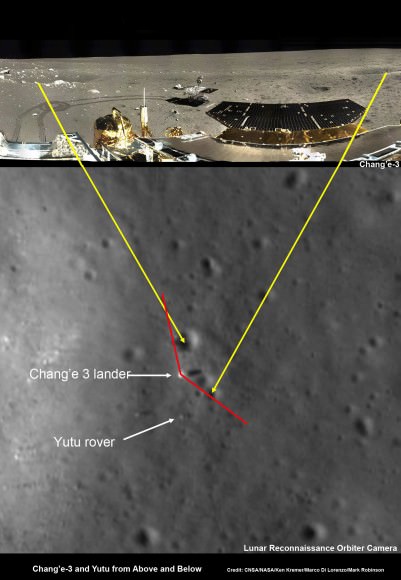
Yutu is now nearing its planned 3 month long life expectancy on a moon roving expedition to investigate the moon’s surface composition and natural resources.
The 1200 kg stationary lander is functioning normally. It is as expected to return science data about the Moon and conduct telescopic observations of the Earth and celestial objects for at least one year.
Yutu, which translates as ‘Jade Rabbit’ is named after the rabbit in Chinese mythology that lives on the Moon as a pet of the Moon goddess Chang’e.
“We all wish it would be able to wake up again,” said Ye according to CCTV, China’s state run broadcaster.
Ye will be reporting about Yutu and the Chang’e-3 mission at the annual session of the top advisory body, which opened today, Monday, March 3.
China is only the 3rd country in the world to successfully soft land a spacecraft on Earth’s nearest neighbor after the United States and the Soviet Union.
Stay tuned here for Ken’s continuing Chang’e-3, Orion, Orbital Sciences, SpaceX, commercial space, Curiosity, GPM, LADEE, Mars and more planetary and human spaceflight news. Learn more at Ken’s upcoming presentations at the NEAF convention on April 12/13.

Shenzhou-8 lands after China’s 1st Space Docking propelling Ambitious Human Spaceflight Agenda
[/caption]
China’s historic first docking mission in space ended in a complete success today (Nov. 17) following the safe landing of the unmanned Shenzhou-8 in Inner Mongolia. Today’s landing will robustly propel China’s space program forward and sets the stage for an ambitious agenda of human spaceflight missions in 2012 to the Tiangong-1 Space Lab and eventually to a hefty 100 ton Earth orbiting Space Station to be assembled by 2020.
Shenzhou-8 was launched to low Earth orbit on Nov. 1 atop a Long March 2F booster from the Jiuquan Satellite Launch Center in the Gobi Desert and successfully conducted China’s first ever rendezvous and docking mission in space with the nation’s Tiangong-1 Space Lab module on Nov. 3 while orbiting some 343 kilometers in altitude above Earth.
Gen. Chang Wanquan, the Commander in Chief of China’s human spaceflight program said, “The Shenzhou-8 capsule has safely returned to the main landing site at Inner Mongolia and the Tiangong-1/Shenzhou-8 rendezvous and docking mission has achieved full success!”
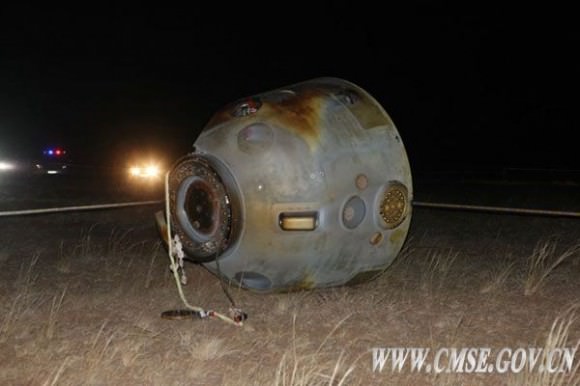
Chang leads the China Manned Space Engineering (CMSE) Project, the nation’s human spaceflight program. He is the Commanding Officer of the Tiangong-1/Shenzhou-8 Rendezvous and Docking Mission Headquarters, and director of the PLA (Peoples Liberation Army) General Armaments Department. The People Liberation Army directs China’s human spaceflight program.
Shenzhou-8 landed today at 7:30 pm. Beijing time in central Asia after flying nearly 17 days in earth orbit. Recovery crews reached the capsule within a few minutes of the parachute assisted touchdown.
Most of the flight was spent linked up to the Tiangong-1 Space Lab module – China’s first prototype space station.

After 12 days of joint orbital operations, Shenzhou-8 carried out a 2nd docking test to enable Chinese space engineers and mission controllers to gain further practice and experience in mastering the complex techniques involved in rendezvous and docking in space.
Shenzhou-8 disengaged from Tiangong-1 on Nov. 14, backed off to a distance of 140 meters (460 ft) and then carried out a re-docking about 30 minutes later. Controllers at the Beijing Aerospace Control Center monitored systems as Shenzhou-8 automatically re-approached Tiangong-1 for the second link up.
The main purpose of the second docking test was to confirm the performance of the rendezvous and docking procedures and hardware on Shenzhou-8 and Tiangong-1 under conditions of the glare of sunlight which are different compared to nighttime conditions of the first docking attempt.
Although the Shenzhou-8 flew unmanned during this flight, the capsule was fully human rated – even food and water are stored on board to simulate the presence of a human crew.
Today’s success sets the stage for possibly two Chinese manned missions to follow in 2012, namely Shenzhou-9 and Shenzhou-10.
Each Shenzhou can carry two or three astronauts. One of the missions is highly likely to include the first female Chinese astronaut.
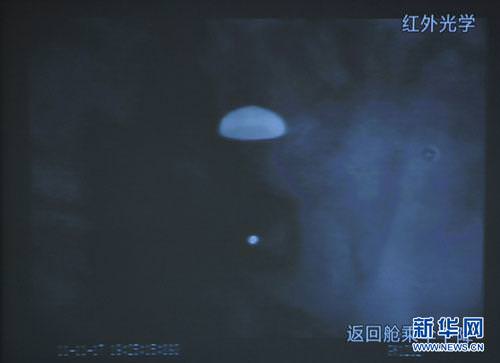
Read Ken’s features about Shenzhou-8 & Tiangong-1
China completes 2nd Docking to Space Lab and sets Path to Manned flights in 2012
China Technology Surges Forward with Spectacular First Docking in Space
China launches Shenzhou-8 bound for Historic 1st Docking in Space
Shenzhou-8 rolled out for Blastoff to China’s 1st Space Station on November 1
Bizarre Video: China’s Tiangong 1 Space Lab Animation set to ‘America the Beautiful’ Soundtrack
China Blasts First Space Lab Tiangong 1 to Orbit
China set to ‘Leap Forward in Space’ as Tiangong 1 Rolls to Launch Pad
China To Launch Space Station in 2010 or 2011
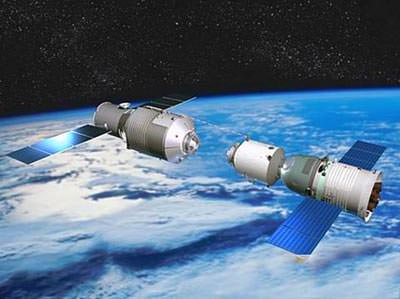
China is planning to launch their own space station, named Tiangong, by the end of 2010 or beginning of 2011. There have been a few instances where information about the station surfaces briefly over the past few years about the development of the space station. Specific details on the program are not being release in large doses by the Chinese National Space Administration (CNSA), so the development of the station is somewhat shrouded in mystery.
Qi Faren, one of the designers of the Shenzhou-5 spacecraft, said in an interview on CCTV last month of the upcoming launch, “Quality is the key to technology. We must guarantee a successful launch. We will launch it whenever we are ready. It will be the end of 2010, or the beginning of 2011.”
Here’s what is known about the program: the Tiangong – which means “Heavenly Palace” – station will start out much as the ISS and Mir did, with a small module to house taikonauts. This component, named Tiangong-1, and shown above, is estimated to be an 8.5-ton module that will have life-support and solar energy production facilities. It’s a rather small module, with not much more room than the Shenzou spacecraft that will later carry taikonauts to the station.
The CNSA unveiled a model of the station during TV special celebrating the New Year in January 2009, but not much more has been said until the most recent statements regarding its potential launch dates.
Shenzhou-7 was the last manned Chinese spacecraft to launch, and it brought astronaut and former fighter pilot Zhai Zhigang into space for China’s first spacewalk. The next launch of a Shenzhou spacecraft, Shenzou-8, will be unmanned and is planned to dock with Tiangong-1, reminiscent of the ESA’s Automatic Transfer Vehicle. Of course, details about the date of this launch will be forthcoming pending the launch of the station itself. This docking mission could last a few weeks to a few months, and will carry a payload of scientific experiments.
After that, Shenzhou-9 and -10 will likely carry taikonauts up to the station. It isn’t really clear whether Shenzhou-9 will be another unmanned docking mission, or will carry the first of the taikonauts to board the station. The success of Shenzhou-8 will have a lot to do with whether the following launch will be manned or not. Any of the missions to the station containing humans would be shorter than the unmanned docking missions for the logistical problems raised by bringing humans into space.
According to the Chinese Academy of Sciences, scientific and support modules will eventually be added to the station, named Tiangong II and Tiangong III.
Further down the road, China plans to build a larger, more long-term space facility. Zhang Jianqi, Deputy Commander-in-Chief of China’s Manned Space Engineering Program, told the Xinhua News Agency last March, “…We will go all out to build a long-term manned space station by 2020.” This fits in well with China’s plans to take humans to the Moon after 2020, as it could provide a support platform for such a venture.
As the launch of the newest addition to human outposts in space approaches, we’ll hopefully get more information as to the details of Tiangong.
Source: Spacedaily, Chinese Academy of Sciences


